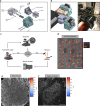A convolutional neural network STIFMap reveals associations between stromal stiffness and EMT in breast cancer
- PMID: 37322009
- PMCID: PMC10272194
- DOI: 10.1038/s41467-023-39085-1
A convolutional neural network STIFMap reveals associations between stromal stiffness and EMT in breast cancer
Abstract
Intratumor heterogeneity associates with poor patient outcome. Stromal stiffening also accompanies cancer. Whether cancers demonstrate stiffness heterogeneity, and if this is linked to tumor cell heterogeneity remains unclear. We developed a method to measure the stiffness heterogeneity in human breast tumors that quantifies the stromal stiffness each cell experiences and permits visual registration with biomarkers of tumor progression. We present Spatially Transformed Inferential Force Map (STIFMap) which exploits computer vision to precisely automate atomic force microscopy (AFM) indentation combined with a trained convolutional neural network to predict stromal elasticity with micron-resolution using collagen morphological features and ground truth AFM data. We registered high-elasticity regions within human breast tumors colocalizing with markers of mechanical activation and an epithelial-to-mesenchymal transition (EMT). The findings highlight the utility of STIFMap to assess mechanical heterogeneity of human tumors across length scales from single cells to whole tissues and implicates stromal stiffness in tumor cell heterogeneity.
© 2023. The Author(s).
Conflict of interest statement
The authors declare no competing interests.
Figures





Similar articles
-
The nanomechanical signature of breast cancer.Nat Nanotechnol. 2012 Nov;7(11):757-65. doi: 10.1038/nnano.2012.167. Epub 2012 Oct 21. Nat Nanotechnol. 2012. PMID: 23085644
-
Length Scale Matters: Real-Time Elastography versus Nanomechanical Profiling by Atomic Force Microscopy for the Diagnosis of Breast Lesions.Biomed Res Int. 2018 Oct 16;2018:3840597. doi: 10.1155/2018/3840597. eCollection 2018. Biomed Res Int. 2018. PMID: 30410929 Free PMC article.
-
Artificial Neural Network-Aided Computational Approach for Mechanophenotyping of Biological Cells Using Atomic Force Microscopy.J Biomech Eng. 2023 Jul 1;145(7):071007. doi: 10.1115/1.4056916. J Biomech Eng. 2023. PMID: 36795020
-
Atomic force microscopy in mechanobiology: measuring microelastic heterogeneity of living cells.Methods Mol Biol. 2011;736:303-29. doi: 10.1007/978-1-61779-105-5_19. Methods Mol Biol. 2011. PMID: 21660735 Review.
-
Harnessing atomic force microscopy-based single-cell analysis to advance physical oncology.Microsc Res Tech. 2024 Apr;87(4):631-659. doi: 10.1002/jemt.24467. Epub 2023 Dec 6. Microsc Res Tech. 2024. PMID: 38053519 Review.
Cited by
-
Atomic force microscopy-mediated mechanobiological profiling of complex human tissues.Biomaterials. 2023 Dec;303:122389. doi: 10.1016/j.biomaterials.2023.122389. Epub 2023 Nov 11. Biomaterials. 2023. PMID: 37988897 Free PMC article. Review.
-
Bio-orthogonal tuning of matrix properties during 3D cell culture to induce morphological and phenotypic changes.Nat Protoc. 2025 Mar;20(3):727-778. doi: 10.1038/s41596-024-01066-z. Epub 2024 Nov 5. Nat Protoc. 2025. PMID: 39501109 Review.
-
Defining and modeling dynamic spatial heterogeneity within tumor microenvironments.Curr Opin Cell Biol. 2024 Oct;90:102422. doi: 10.1016/j.ceb.2024.102422. Epub 2024 Aug 30. Curr Opin Cell Biol. 2024. PMID: 39216233 Free PMC article. Review.
-
Local soft niches in mechanically heterogeneous primary tumors promote brain metastasis via mechanotransduction-mediated HDAC3 activity.Sci Adv. 2025 Feb 28;11(9):eadq2881. doi: 10.1126/sciadv.adq2881. Epub 2025 Feb 26. Sci Adv. 2025. PMID: 40009679 Free PMC article.
-
Epithelial-Mesenchymal Plasticity and Epigenetic Heterogeneity in Cancer.Cancers (Basel). 2024 Sep 27;16(19):3289. doi: 10.3390/cancers16193289. Cancers (Basel). 2024. PMID: 39409910 Free PMC article. Review.
References
Publication types
MeSH terms
Substances
Grants and funding
LinkOut - more resources
Full Text Sources
Medical
Molecular Biology Databases
Research Materials
Miscellaneous

